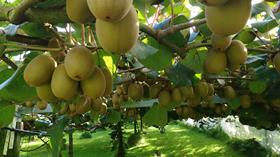
New Zealand’s Northland could be set to grow its share of the kiwifruit production pie, according to a new report from a leading Australasian bank.
ANZ’s 2018 Kiwifruit Industry paper suggests the region currently grows 1 per cent of the country’s green kiwifruit crop and 5 per cent of the Gold3 (Sun Gold) crop. These figures are dwarfed when compared to those of New Zealand’s primary production hub, the Bay of Plenty, where over 85 per cent of green fruit and 76 per cent of Sun Gold are grown.
However, with limited greenfield land available in the Bay of Plenty, the report suggested future sales of SunGold licences by single-desk marketer Zespri would require alternative growing regions to be developed.
“Northland’s subtropical climate and wide diversity of soil is being considered by industry participants as an area with strong growth potential, which would suit the SunGold variety. With an already established grower network, Northland’s kiwifruit industry has the opportunity to grow.”
Forecasts from the University of Waikato predict kiwifruit earnings in the Northland will more than double to NZ$72m by 2030, with the number of jobs expected to increase from 380 to 886.
While Sun Gold is seen as a key driver for growth across the industry, based on its higher revenue stream, the ANZ report suggested further financial and opportunity cost analysis should be undertaken before converting already productive green kiwifruit orchards.
“This is particularly so given global demand for green kiwifruit remains strong and there is an overall industry requirement to maintain export volumes at current levels to satisfy global demand.”
The same logic appears to apply for a string of new varieties in the pipeline. Zespri has spoken openly about its desire to add a red cultivar to its mix, with trials currently taking place across the country. A new, sweeter tasting green variety is also on the cards.
“Growers take a commercial risk in planting a new variety by converting part of the existing productive orchard to make room for new kiwifruit,” the report said. “This causes losses in income and cashflow for two to three years until the new vines becomeestablished.”



